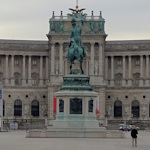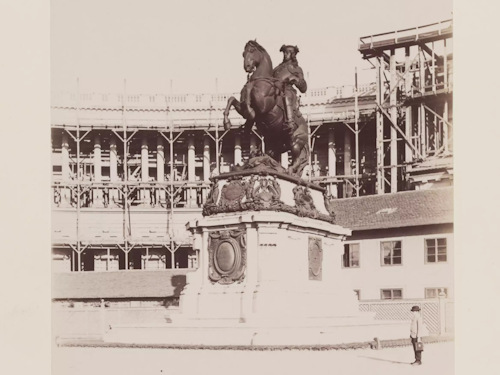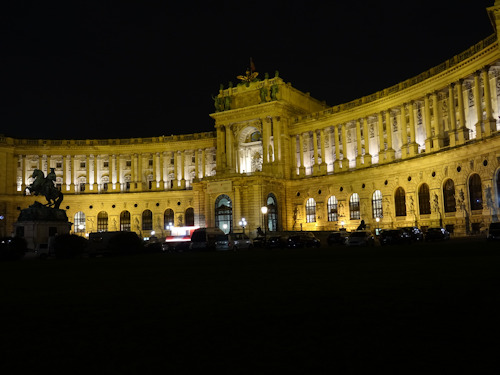
The Hofburg winter palace is actually a complex of courtyards and historical tracts that lacks a single standalone gem of a building. But one part does tick all the right architectural boxes: the Neue Burg.
- Relatively new wing of the palace area (completed in the early 20th century)
- Home to the National Library, the Weltmuseum, the Museum of Austrian History, and more
- Hitler infamously used the terrace to announce Austria’s Anchluss with Germany
- Browse and book a guided tour* for Vienna
- See also:
Unfinished business

(The front view across the square)
The Neue Burg forms an extended wing from the main Hofburg palace area and lines one side of Heldenplatz square (see the photo above) in the centre of Vienna.
Despite the grand look, this building is a relative baby in Vienna’s historical architectural landscape.
When the city walls came down in the mid-1800s and the great period of construction began around the edge of the old town, plans were made to build an imposing set of imperial buildings known as the Kaiserforum.
Unfortunately, the good intentions foundered on such small matters as cash, project management, and the inappropriateness of all things imperial given the end of the monarchy.

(The Prince Eugene monument, photographed by Friedrich Strauß in 1895. You can see the Neue Burg and construction scaffolding behind; Wien Museum Inv.-Nr. 94600/22/2; excerpt reproduced with permission under the terms of the CC0 licence)
Only part of the Kaiserforum saw the light of day: the gorgeous Kunsthistorisches and Naturhistorisches museums, for example…and the Neue Burg.
Construction on the new wing began in 1881, but various delays meant work was still ongoing at the end of World War I.
The new building should have provided apartments for the Imperial family and associates, with rooms for guests and other luminaries in a twin building opposite that never got past the planning stage.
By 1918, however, the need for imperial apartments had largely disappeared (on account of there being no imperial family to go in them).
The Neue Burg today

(The Weltmuseum is one of several institutions that count the Neue Burg as its home)
Construction work continued (particularly inside) over subsequent years, with the Neue Burg fulfilling a changing variety of functions. It eventually assumed its current form and purpose, which is to offer a home to the national library and various museal collections.
As such, you cannot visit the Neue Burg per se. But you can visit the various institutions within to get a look at the rather extraordinary architecture, design, and interior decoration.
Your best option is probably to visit the Weltmuseum on the right of the building as you face it (the magnificent atrium requires no entrance ticket to view).
A ticket for this ethnographic museum does, however, include entry to:
The Armoury, in particular, proves great for viewing huge curving halls: look for the one with the full models of tournament horses and knights.
Other locations within the Neue Burg include:
- The National Library (the modern library and the Papyrus Museum, but not the astonishing Prunksaal, which you access from the nearby Josefsplatz square)
- The Hofburg info centre and imperial shop (now integrated with the Weltmuseum shop, too)
- The Ephesos Museum (also a wonderful way to see marbled halls and staircases)

(The building looks lovely at night)
Despite its youth, the Neue Burg did witness one of the most memorable (for all the wrong reasons) moments of world history.
On March 15th, 1938, Adolf Hitler stood on the balcony before the cheering crowds and formally announced that Austria had been absorbed into Nazi Germany.
As one newspaper wrote the next day (my rough translation):
Unimaginable expressions of joy and enthusiasm rang out for minutes across Heldenplatz after many words of the Führer
Not one of Vienna’s greatest moments, to say the least.
Incidentally, the statue immediately outside this great curved building commemorates Prince Eugene of Savoy. Our man Eugene wasn’t even a Habsburg (or Austrian), but he did an awful lot to keep the dynasty in power and possessions.
How to get to the Neue Burg
Meander around Vienna’s centre and you’ll likely bump into the Neue Burg, anyway, as you explore the Hofburg area and soak up the atmosphere in the historical old town.
Subway: the closest station is Museumsquartier on the U2 line. But it’s only a short walk from Volkstheater (U3 and U2), Herrengasse (U3) and Stephansplatz (U3 and U1).
Tram/bus: the Ring trams stop practically outside. Take the 1, 2, D or 71 to Burgring.
Address: Heldenplatz, 1010 Vienna